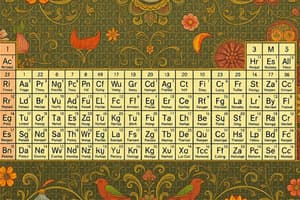Podcast
Questions and Answers
What was the purpose of classifying elements in the 19th century?
What was the purpose of classifying elements in the 19th century?
- To complicate the field of chemistry.
- To make the study of individual elements easier. (correct)
- To keep the atomic masses a secret.
- To confuse scientists with unnecessary classifications.
What did Dobereiner attempt to do with his 'Triads' classification?
What did Dobereiner attempt to do with his 'Triads' classification?
- Classify elements based on their size.
- Classify elements with similar properties into groups of three. (correct)
- Classify elements into two big groups.
- Classify elements based on their color.
According to Dobereiner, what was unique about the atomic mass of the element in the middle of a triad?
According to Dobereiner, what was unique about the atomic mass of the element in the middle of a triad?
- It was always lower than the mean of the other two atomic masses.
- It was always equal to the mean of the other two atomic masses. (correct)
- It had no specific relationship to the other two atomic masses.
- It was always higher than the other two elements.
How many triads were mentioned by Dobereiner in his classification system?
How many triads were mentioned by Dobereiner in his classification system?
What was one of the limitations of Dobereiner's Triads classification?
What was one of the limitations of Dobereiner's Triads classification?
Why was it important to classify elements into groups during the 19th century?
Why was it important to classify elements into groups during the 19th century?
Which statement best describes Dobereiner's approach to classification?
Which statement best describes Dobereiner's approach to classification?
'Triads' in Dobereiner's classification system consisted of how many elements?
'Triads' in Dobereiner's classification system consisted of how many elements?




